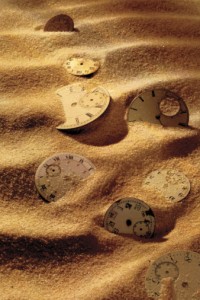When up is Down (Part 4)
By Asher Crispe: September 13, 2012: Category Inspirations, Thought Figures
Kabbalistic Reflections on T.S. Eliot’s Four Quartets
Time present and time past
Are both perhaps contained in time future,
And time future contained in time past.
–T.S. Eliot Burnt Norton I
 On the most basic level, the entirely of Eliot’s Four Quartets can be framed as a meditation on the nature of time. Temporal mysteries are so fundamental to the human condition that philosophers such as Martin Heidegger have even formulated that we are ourselves time (“time is Dasein”….Dasein is time, time is temporal. Dasein is not time, but temporality” [The Concept of Time p. 20e]). Without slicing into the particulars of Heidegger’s argument, let us simply grant this assumption and employ it in our reading of these first lines of Eliot’s poem. In doing so, it is possible to personalize the words that we are scrutinizing.
On the most basic level, the entirely of Eliot’s Four Quartets can be framed as a meditation on the nature of time. Temporal mysteries are so fundamental to the human condition that philosophers such as Martin Heidegger have even formulated that we are ourselves time (“time is Dasein”….Dasein is time, time is temporal. Dasein is not time, but temporality” [The Concept of Time p. 20e]). Without slicing into the particulars of Heidegger’s argument, let us simply grant this assumption and employ it in our reading of these first lines of Eliot’s poem. In doing so, it is possible to personalize the words that we are scrutinizing.
Starting again, we may reread with an interpellation of self “[my] time present and [my] time past, are both perhaps contained in [my] time future, and [my] time future contained in time past.” We feel possessive of time. It is the time which is mine. I claim ownership over it. If the consciousness of a specific time and the experiences that took place within it were to be withdrawn or pass away, I sense that I have been cheated or robbed in some way. This experience of loss is much more than nostalgia. Where do those events exist now? What if they are forgotten? If they were only buried in my head, then their afterlife depends on me and my memory. But my memory can fail. Catastrophic memory failure has deleterious effects.
We desire the persistence of both the present ‘I wish this moment would last forever’ and the (ideal) past i.e. ‘the good old times.’ Hence, we try give ‘presents’ to ourselves or to pacify the past with thoughts of returning to or recalling those moments and the events that occupied them. Better still, we would like to relive the moment virtually. All our ‘times’ would never have to fade away nor would they need to recede into the distance. All I have to do is change the channel and my mind leaps from tense to tense. All times are somehow entangled.
Practically speaking, this means that the first grader inside of me is still there and I may return to that size and mentality. An all-sessions trans-temporal passport means universal access wherein I can see the world through those eyes whenever I want to. When I go back to being that way (or rather when my being is temporized in that manner) I experience a strange temporal collision: my former self has run into my present self in the strangest of encounters. I can even rear-end my future by accelerating ahead of my time. This bizarre situation creates the greatest problems as far as insurance claims.
In the Torah, the resurrection of the dead cannot only mean a revival of the person. It must also include all of that person’s life-experience. Coming back in the future (the past and the present relocated to the future) cannot have meaning if they are wiped clean. How else could I recognize it as me returning? That summer trip with my parents, my wedding day, the births of my children along with the perceptions, thoughts and feelings, the words I exchanged and the images I saw–I want to keep them too.
This is radically different from anonymous, homogenous and abstract ‘presents’ and ‘pasts’ recycling over and over, on and on, into the future. The fact that there could always be more Thursdays will not satisfy my need to hold onto this Thursday. I am concerned (and I believe Eliot is too) with my time and your time. If my concern extends to the world’s time or even cosmic time, it is primarily because those ‘collective times’ play host to our particular time. One temporal order nests within another.
In Kabbalah, this is the sense of general time (zeman klali) and particular or personal time (zeman perati). The relationship between them is likened to a masculine/feminine pair. Thus, the most accurate picture would involve a marriage of the two. Having them unwed is seen as a negative existential condition.
Another coupling in Kabbalah revolves around the distinction between actual time (zeman poel) and potential time (zeman b’koach). Actual time, as the kabbalists understand it, denotes the situation when matter contracts it form. The form in this instance is the soul of time which by itself remains unbound and unmeasured. By matter we mean to say the substantialization of time or temporal concreteness. The soul of time is encased and anchored in finite and measurable things, experiences, events and most of all people. Thus form and matter are equivalent to soul and body.
Potential time is a ‘giving of time’ or masculine seed of time. This transmission or giving of time, this source of temporality itself is a kind of timeless time. Timeless time signifies the compresence of past, present and future together just like the Tetragrammaton expresses hayah [past], hoveh [present] and yihiyeh [future]. By contrast, feminine time represents the embodiments of time within the world. The Mittler Rebbe, who reflected on the subject of time extensively, writes [Maamorei Admur Hoemtzoee Shemois I pp.102-103] that feminine time is like the ‘days of the world.’ ‘Days’ are finite measures of time predicated upon a certain world context–in this case the situatedness of the earth relative to the sun. Eternal temporal forms (like the Jewish holidays and Sabbath) give time to be temporalized. The ‘mattering’ or ‘incorporation’ of time is the timing of time as soul joined to body.
 The problem of entropy, which is bound up with the idea of an arrow of time, erodes the connection between the soul of time and the body of time. The soul leaves and the body of time breaks down. As a result, the redemption of time must be seen in messianic terms. The messianic age is usually thought together with the resurrection of the dead in Judaism. When these concepts are combined according to the Mittler Rebbe [ibid. p.106], the source of time (or the masculine time above time) will be permanently united with real time (or measured and embodied ‘feminine’ temporalized time). Since the source is always an ‘open’ and unmeasured limitless eternity of time or temporal collective, its conjunction with a closed or sealable finitude of particular time reflects on the greatest of all puzzles. Simply put, it means you can have your cake and eat it to. It is the paradox of temporal consumption and preservation.
The problem of entropy, which is bound up with the idea of an arrow of time, erodes the connection between the soul of time and the body of time. The soul leaves and the body of time breaks down. As a result, the redemption of time must be seen in messianic terms. The messianic age is usually thought together with the resurrection of the dead in Judaism. When these concepts are combined according to the Mittler Rebbe [ibid. p.106], the source of time (or the masculine time above time) will be permanently united with real time (or measured and embodied ‘feminine’ temporalized time). Since the source is always an ‘open’ and unmeasured limitless eternity of time or temporal collective, its conjunction with a closed or sealable finitude of particular time reflects on the greatest of all puzzles. Simply put, it means you can have your cake and eat it to. It is the paradox of temporal consumption and preservation.
In Part 5 we will continue to explore this paradox in light of both ethical and spiritual concerns about time.













;)
;)
;)
;)
;)
;)
;)
;)
;)
;)
